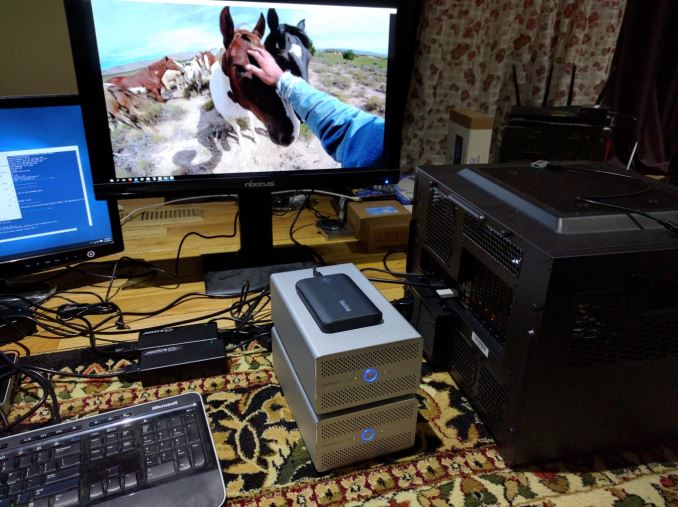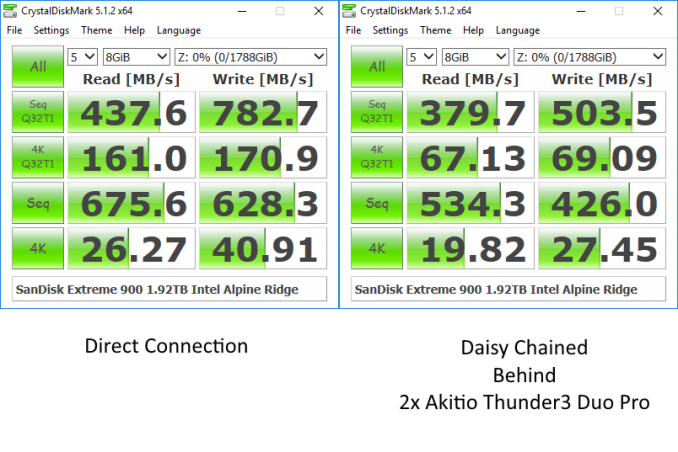Thunderbolt 3 in Action: Akitio Thunder3 Duo Pro DAS Review
by Ganesh T S on April 14, 2016 8:30 AM EST- Posted in
- Storage
- DAS
- Thunderbolt 3
- Akitio
Daisy Chaining
The full capabilities of Thunderbolt 3 are brought out when we have a series of devices hooked up in a daisy chain fashion to the testbed. Thunderbolt has always supported DisplayPort monitors at the end of a daisy chain. With Thunderbolt 3, any USB device with a Type-C interface can terminate the chain. The design of the Akitio Thunder3 Duo Pro ensures that a DisplayPort monitor does not need to be a link in the daisy chain, but can hang off as a node. We performed some testing with the following daisy chain configuration:
- AnandTech Skylake DAS Testbed with 2x Thunderbolt 3 (TB3) ports
- TB3 Port 1 of testbed connected to TB3 Port 1 of Akitio Thunder3 Duo Pro A
- TB3 Port 2 of Thunder3 Duo Pro A connected to TB3 Port 1 of Thunder3 Duo Pro B
- Nixeus Vue-27D 2560x1440 DisplayPort monitor connected to DisplayPort output of Thunder3 Duo Pro B
- SanDisk Extreme 900 1.92TB connected to TB3 Port 2 of Thunder3 Duo Pro B
The daisy chain setup is brought out in the photograph below.
IOMeter is one of the most reliable tools to measure performance while accessing multiple storage nodes simultaneously. In order to get maximum performance, we set up the two Akitio Thunder3 Duo Pro units in JBOD mode. Including the SanDisk Extreme 900, we ended up with five different physical disks that could be accessed over the single Thunderbolt 3 link. We ran the standard 128K sequential accesses with a queue depth of 4 and the 4K random accesses with a queue depth of 32. The table below shows the bandwidth realized as a function of the number of disks accessed simultaneously.
| 2x Akitio Thunder3 Duo Pro with 4x Intel SSD DC S3510 + SanDisk Extreme 900 (Thunderbolt 3 + USB 3.1 Gen 2 Daisy Chaining) IOMeter Benchmarks (MBps) |
||||
| Number of Simultaneous Disk Accesses | Write Bandwidth | Read Bandwidth | ||
| 128K Seq QD4 | 4K Rand QD32 | 128K Seq QD4 | 4K Rand QD32 | |
| 1 | 243.30 | 45.39 | 334.51 | 226.95 |
| 2 | 508.89 | 198.69 | 671.14 | 178.00 |
| 3 | 749.80 | 199.19 | 943.28 | 159.88 |
| 4 | 1010.37 | 160.12 | 1229.20 | 131.81 |
| 5 | 1489.72 | 172.68 | 1761.13 | 153.85 |
The sequential access numbers show that the link is nowhere near getting saturated despite pushing across more than 1700MBps (not accounting for the DisplayPort bandwidth here). However, with two bay devices supporting only SATA drives, it is difficult to sustain more traffic than what we have recorded here. That said, as more peripherals start coming out (in the form of docks or even units with 10+ drive bays), Thunderbolt 3 can show its true benefits.
Performance Implications
Daisy chaining is a nifty feature, but users must realize that as one goes further down the chain, the performance of the peripheral decreases. We studied this aspect further by using the SanDisk Extreme 900 USB 3.1 Gen 2 Portable SSD. In our first test, we connected the portable SSD directly to the Thunderbolt 3 port of the testbed. CrystalDiskMark was run with Alpine Ridge acting as a pure USB 3.1 Gen 2 host. In the second test, we connected the portable SSD to the free Thunderbolt 3 port on the Thunder3 Duo Pro that was farthest from the testbed (in the configuration mentioned at the top of this section).
The numbers clearly show a significant drop in performance as the peripheral gets further and further away from the main system. Similar drop in performance was noted for ATTO and all our real-life benchmarks (robocopy and PCMark 8 storage bench) also.












60 Comments
View All Comments
ganeshts - Saturday, April 16, 2016 - link
I would have agreed with you a year or so back, but the good thing here is that Thunderbolt has emerged successfully out of the Mac shadow. At present, every Thunderbolt 3 device out there is compatible with Windows only, and not Mac.From a system perspective, for a very little premium, board vendors can integrate USB 3.1 Gen 2 + Thunderbolt 3 into their notebooks and consumers can get more out of that integrated port compared to a pure USB 3.1 Gen 2 Type-C port. Whether that extra premium is worth it, the consumer should figure out. The board we used - GIGABYTE Z170 board with Alpine Ridge integrated - can be purchased for less than $200. I think at this price, compared to a vanilla system, consumers might be OK with something a bit more future-proof.
From a device perspective, yes, lots of Thunderbolt peripherals are overpriced. But, eGFX solutions will definitely be attractive to a lot of gaming folks who are looking for portability. Then, there is Thunderbolt networking which is attractive for small workgroups (more of a business use-case there). Daisy chaining is another great feature for thin systems.
Frankly, a year or two back, I wouldn't have been bullish on Thunderbolt, and would have equated it with Firewire. But, with Thunderbolt 3, I think Intel has finally converged on to the right type of solution.
theduckofdeath - Saturday, April 16, 2016 - link
Mobile gaming with an external GPU will stay a niche, as the bottleneck will still be the poorly cooled mobile technology within the notebook. Especially with DX12 and the likes, processor and motherboard component performance will be a lot more relevant than it has been since Microsoft introduced the hardware extraction layer to Windows last decade.And it's not just "some" TB accessories that are overpriced for what you get. Like the previous commenter said, you can build an actual PC for the price of this external case. Use it for storage if you like, or whatever else you'd want to use a spare PC for.
bobj3832 - Saturday, April 23, 2016 - link
I've worked in small offices with 6 people and huge corporations with over 100,000 employees. In every company we always had file servers on the network. Virtually no one kept data locally (except travelling sales people) If your workstation goes down just log in somewhere else and continue working.For my personal stuff at home I have a 10 gigabit network. The SATA interface (even for the SSDs I have in the file server) is the bottleneck.
I just don't have any need for Thunderbolt with a 10G network.
bobj3832 - Saturday, April 23, 2016 - link
And before someone complains of the cost I got used SFP+ cards for $20 each and a switch with 4 SFP+ ports for $520. It also has 24 1G ports.JHBoricua - Saturday, April 23, 2016 - link
Umm, and I had to log to the site to point how your comment on software raid was even more silly.What happens if the machine running a software RAID dies, you ask? Simple. Since it is software RAID, you simply mount the RAID volume on another PC running the same Os. That's the beauty of software RAID, it is not tied to the hardware.
Let me ask you this. What happens when the failed device happens to be this enclosure with its 'hardware' RAID? Well, you better have a spare one of the same make/model lying around or you won't be able to recover the data. But hey, you'll probably be able to use the same cable.
Seriously, did you even pause to think before commenting on the merits of software RAID vs this device?
damianrobertjones - Thursday, April 14, 2016 - link
I recall, all those years ago, that USB was supposed to feature daisy chaining.HideOut - Thursday, April 14, 2016 - link
Never. But I think firewire was. USB has always been hub + spoke layout. FW could chain I think.DanNeely - Thursday, April 14, 2016 - link
You could fake daisy chaining in USB by connecting hubs to each other; and in theory there was no reason you couldn't make a device with a 2port hub that used 1 port internally and exposed the 2nd for daisy chain type usage. Aside from a few higher end keyboards I've never seen anything like this done.FW had direct proper support for daisy chaining; but neither of the FW HDD enclosures I owned supported it.
hrrmph - Friday, April 15, 2016 - link
That's how most high-port-quantity USB hubs do it. They internally daisy chain. A "normal" USB hub is typically 4-ports. Use the last of those 4 ports to daisy chain to 4 more ports. The user sees a physical 7 ports on the outside of the hub.Vidmo - Thursday, April 14, 2016 - link
Waiting on the eight drive version to replace my current USB 3.0 local DAS backup solution. Backing up 36TB of data takes a long time over USB 3.0.